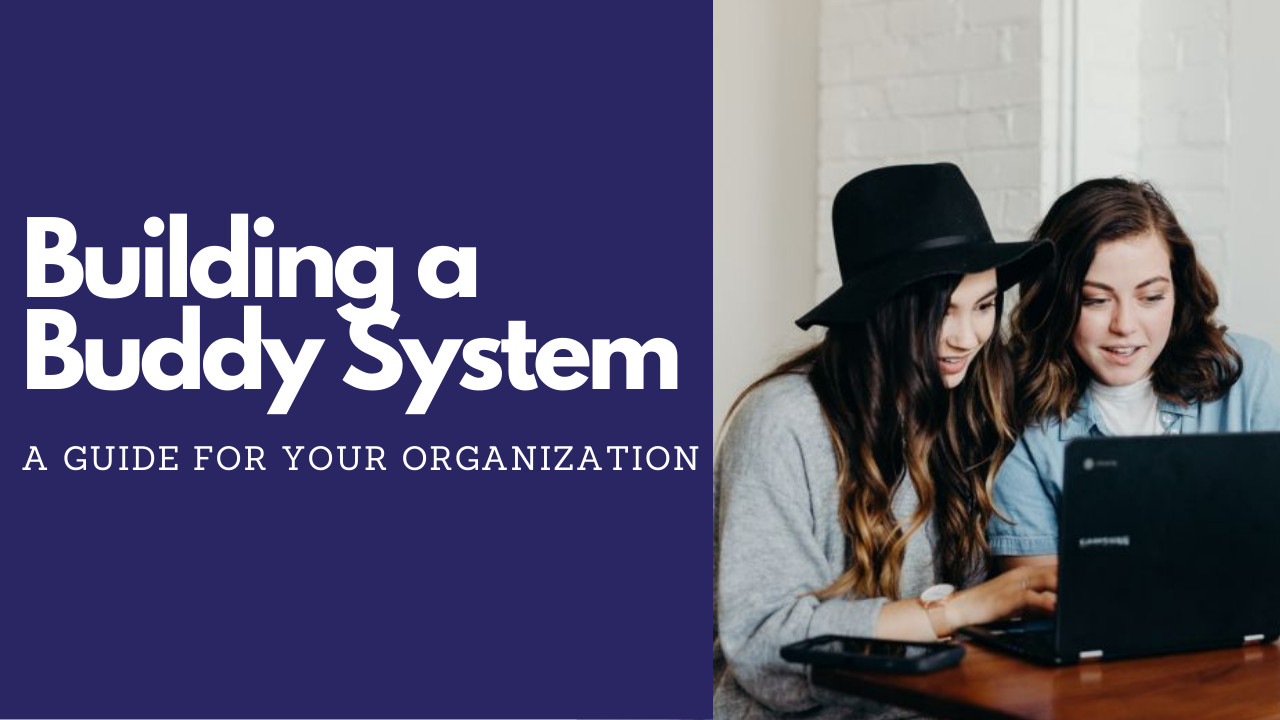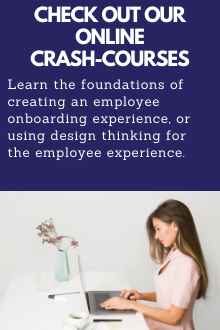A Guide To Building A Buddy System
A Buddy System is one of the best ways to improve the employee experience.
The buddy system is a science-backed (as we’ll look at in this post) approach that does wonders for new employees. It helps get up to speed, and helping them feel that they’ve made the right choice in joining your organization.
In my post on employee onboarding ideas your organization can use, I wrote a brief synopsis on the value of a buddy system.
I also talked about the importance of a buddy system on the following podcast:
Transform Your Workplace Podcast: Fun at Work with Paul Lopushinsky
I also talked about the buddy system during my talk at Remote Workplace Success Summit 2021: “Best Practices for Remote Onboarding”
What Will This Guide Cover On The Buddy System?
- What Is A Buddy System?
- Why Should You Have A Buddy System?
- Who Should Be A Buddy?
- What Should A Buddy Be Responsible For?
1. What Is A Buddy System?
So you’ve started a new job. You go into the office or log into Slack. You have butterflies in your stomach. It’s ok, we all do on the first day.
Luckily for you, you’re matched with someone the first day who:
- Shows you the ropes
- Gets you up to speed on the culture
- Lets you know about the unwritten rules that exist
- Someone to turn to for guidance
This, in a nutshell, is a buddy.
Saw this cheesy stock photo, knew I had to make use of it.
How does a buddy vary from a mentor, or a coach?
I get asked this question often. I’ll admit that I sometimes use buddy and mentor in an interchangeable manner.
Here’s a breakdown of the difference between the three that I found here:
Desinging a Buddy Program:
A coaching program seeks to increase the individual”s job-related skills;
A buddy program is solely involved with providing a one – point access to operationally necessary information. In essence, the development of the individual is not an expected output.
2. Why Should You Have A Buddy System?
So why should you have a buddy system? What are the benefits?
Let’s take a look at what happened at Microsoft when they implemented a buddy system:
Every New Employee Needs an Onboarding “Buddy”
They can also shed light on cultural norms and any unspoken rules that exist, which could lead to a much smoother transition into the organization.
At Microsoft, we found the more the onboarding buddy met with the new hire, the greater the new hire’s perception of their own speed to productivity: 56% of new hires who met with their onboarding buddy at least once in their first 90 days indicated that their buddy helped them to quickly become productive in their role. That percentage increased to 73% for those who met two to three times with their buddy, 86% for those who met four to eight times, and 97% for those who met more than eight times in their first 90 days.
Our research found that after their first week on the job, new hires with buddies were 23% more satisfied with their overall onboarding experience compared to those without buddies. This trend continued at 90 days with a 36% increase in satisfaction. Those with buddies also reported receiving more active support from both their manager and the broader team.
So there you go…you have some numbers to go along with it. If Microsoft uses it, why shouldn’t you?
Please note the FAANG effect which I’ve written on. Don’t copy what another organization is doing. That said, the buddy system is one of the most cost-effective, result-driven ways to improve the employee experience.
The Importance of Having A Good Friend At Work.
Gallup has been doing research for employee engagement for decades.
What is one of the most controversial questions that they ask? It’s the following:
“Do you have a best friend at work?
Here are some key points from an article from Gallup on the topic: Why We Need Best Friends at Work.
We spend more of our waking hours at work than at home, and it’s only natural that we want to build connections with our team members. We want work to feel worthwhile and having trusted confidants and supporters helps foster that feeling.
We go to our work friends when we need to celebrate and commiserate about our personal and professional lives. In the absence of that outlet, work can seem lonely and isolating.
For example, our employee engagement database shows that a mere two out of 10 U.S. employees strongly agree they have a best friend at work. Yet, by moving that ratio to six in 10, organizations could realize:
• 36% fewer safety incidents
• 7% more engaged customers
• 12% higher profit
We discovered that women who had a best friend at work are:
• less likely to be actively looking or watching for job opportunities
• more connected with their coworkers, knowing what is expected of them and trusting their integrity and ethics
• more likely to rate their own, their team’s and their organization’s performance more excellently
• more likely to take risks that could lead to innovation
While there is no guarantee the matched buddy is going to become their best friend at work, it does increase the chances of it.
What are some other reasons of why you should use a buddy system?
- A buddy gives new employees the chance to give candid feedback about the employee onboarding experience, which they may be more shy to give to their manager.
- From the Gallup Q12 study, one of the most important questions to employee satisfaction is “what is expected of me”, which a buddy can help out with.
- A buddy can be someone they can to about things that they should know, but are afraid to ask. A buddy is one of the best ways to help get the “unwritten rules” across to the new employee.
3. Who Should Be A Buddy?
This is what prompted this post in the first place. I’ve gotten a few of these questions in the past when it comes to the buddy system:
- Who would be a good fit to be a new employees buddy?
- Should being a buddy be voluntary, or mandatory?
- We’re having a hard time getting employees to become buddies. What should we do?
So let’s take a look at what you can do.
Consider having more than one buddy.
Who says you need only one buddy?
The social media scheduling organization Buffer does the following with its buddy system:
What Happened When We Renamed a Job Listing: Hiring at Buffer in August 2015
The Leader Buddy is a very experienced member of the team who has practiced and experienced handling tough conversations around helping bootcampers live to the Buffer values.
The role buddy is someone on the team who understands the role which the bootcamper is joing the team to play.
The Culture Buddy is an experienced member ofr the team who has shown that they consistently are able to give great praise and feedback around the culture-fit of new and exisistng team members.
We feel that three buddies is a great way to give bootcampers a variety of interactions within and outside of their core areas.
One great thing about having several buddies is it eases some of the burden if you’re using one person. Having more than one buddy gives a variety of perspectives and experiences.
Another good thing about having several buddies is it also eases the burden if buddy and new employee are not a good match. What sometimes looks good on a sheet of paper, isn’t the case once they get to know each other.
It happens, don’t start playing a blame game with it. Find someone else instead to be their buddy.
Experienced Employees Make For (Mostly) The Best Buddies.
Your best bet for having a strong buddy is to have someone that’s been at the organization for a time. They’ve seen many changes, known the ins and outs, and can pass on valuable knowledge to new employees.
That said, you have to consider several factors as well for a right fit. You want to be careful that the following doesn’t happen:
- Said buddy is the grouchy one (AKA the disgruntled employee) who may not paint the best picture. That said, they may paint a more accurate one, but those first impressions are key.
- Don’t match them with a buddy who leaving for three weeks for vacation, or always on the road for work and the new employee becomes an afterthought.
On that note, you shouldn’t overlook employees who haven’t been there as long. They’ve gone through the onboarding experience more recently. They will have a better idea of what being in new employees is like. They can do much to help make the transition for new employees more smooth.
Perhaps matching them with someone 3 months from retirement isn’t the best idea.
What Makes Someone A Good Buddy?
You have to give some thought to what makes for a good buddy. After all, a buddy system needs quality buddies to work.
Some of the following are characteristics of a good buddy:
- Patient and understanding
- Excellent communicator and listener
- Supportive
- Knowledgeable about their work
- Easy to approach
- Willing to make time for their buddy
Should Your Buddy System Be Mandatory Or Optional To Participate In?
I posted in the HR Open Source Facebook group on how to incentivize employees to be buddies for new employees.
One response I got is that they made it a job requirement at certain levels. For those that were in senior positions and up, it was part of their role.
Others chimed in that long term, making it voluntary is the best approach. Here are some things that people said on that front:
Willing is a key word here. If someone doesn’t want to be a buddy for whatever reason, that’s fine.
It’s possible that their personality or their role wouldn’t make a good fit for someone new at the organization.
If someone wants to be a buddy, then your organization should make it easy for those who are willing.
On the note of incentives, one mentioned they tried giving more vacation days as an incentive to become a buddy. It worked for a short period of time before it fizzled out.
The last thing I want an organization to do is have a buddy system voluntary and use that against those who don’t want to be buddies.
It’s like the whole idea of “mandated fun”. If people don’t want to be a buddy for whatever reason, then so be it.
Continuing on, let’s see what others have said from the Facebook post I made in #HROS:
Also, all active “Buddies” had a badge and buddy lanyard. They were recognised by their managers, we called them “Extra Mile award”.
They have to want to be a buddy, but then we recognise and thank the buddies at townhalls, also there is a values assessment piece at year end performance review and be an amazing buddy goes towards values based performance goals. The comes off the back of the business owning onboarding enabled by hr and not hr being responsible for everything.
By framing it as a chance to help develop leadership skills, you set yourself in getting more people onboard (no pun intended) as being a buddy for new employees.
I found this one quite interesting. If they want to be able to hit the VP level, they have to be a buddy for new employees.
Usually, this isn’t the case, as most VPs will not have the time, or dedication to do so.
4. What Should A Buddy Be Responsible For?
What Kind of Things Should Be Discussed Amongst Buddies? Give them a baseline of suggestions to get started on what to discuss in their conversations.
Buddies should be meeting at least once a month. This will depend on many factors, but even having weekly discussions if possible is ideal. The more, the better.
Lunch or coffee is always a good choice for a more casual environment. I know some organizations have a budget for buddy lunch outings. A nice little incentive to have.
What are some specific discussion points?
- What onboarding and early days were like for the buddy.
- The unwritten rules at the organization.
- Some of the ups and downs the experienced buddy has had at the organization.
- Things the experienced buddy wish they knew when they first started working.
These are guidelines. The last thing I want is for to go through question by question, as if they were just making their way through a checklist. That’s not what’s needed here. For more of my reasoning, please read my article on employee journey mapping.
What is a buddy not responsible for?
What is almost as important is what a buddy is NOT responsible for. They are not going to become the be-all and end-all for newer employees.
As mentioned earlier, a buddy system isn’t for personal and professional development. That falls into the role of someone who is a mentor or a coach.
There are elements of the buddy system that tackle culture. The unwritten rules of the organization are an example. When it comes to areas like policies and expectations, that is going to fall to areas like HR.
A buddy needs to be a buddy and not their manager. They don’t need to be watching their progress or helping them with work.
They have enough on their plate as is. Don’t add more to it.
Setting these boundaries is key to success with a buddy system. What they are not as responsible for is almost as important.
I’ve chatted with friends who dealt with burnout through a buddy system. There wasn’t a clear case of boundaries and expectations of what they should be doing.
Instead of being a buddy, they became more of a babysitter or glorified manager. Something that added far more stress to their day-to-day.
Conclusion And Next Steps.
We went over the following in this post:
- What Is A Buddy System?
- Why Should You Have A Buddy System?
- Who Should Be A Buddy?
- What Should A Buddy Be Responsible For?
What should be your next steps?
This depends. Do you currently have a buddy system in place? If not, why?
If you do have one, what have been the challenges you have? When you first started, think back to your time in the buddy system as a new employee. What worked, and what didn’t?
Do you struggle on getting current employees to become buddies for new employees? Ideally, you don’t want to force them. Read this post again and see of ways you can come up with that helps give incentives to current employees to become buddies, without resorting to gift cards.
Another great way to improve your employee onboarding experience is making use of the The 30-60-90 Day Plan, which I’ve written about here.
I hope this post helped you gain an understanding of the buddy system and how valuable of a tool it is that you can add to your employee onboarding toolbox. Thanks for reading.







